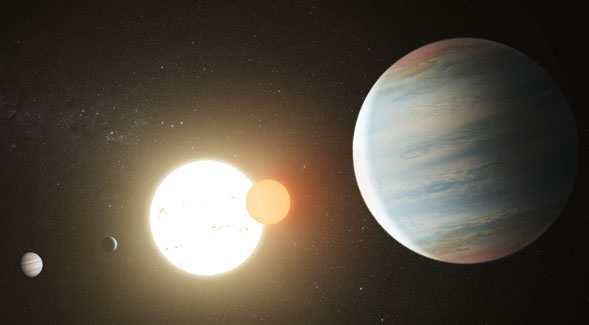
A group of San Diego State astronomers located a third planet within the Kepler 47 system with findings unique to other circumbinary planet discoveries.
Kepler 47b, a circumbinary planet – meaning one that orbits two stars instead of one – was found to orbit between the two other planets in the Kepler system, according to astronomy professor and study co-leader William Welsh.
“What makes this special is there’s no system like this; three planets orbiting around two stars,” Welsh said. “The surprise is that the new planet orbits in between the other two.”
Welsh also said Kepler 47b is the largest of the three planets, 3,340 light years away and is much larger in comparison to Earth.
“The new one’s about seven times larger than the Earth in size which makes it similar to the size of Neptune and Saturn,” Welsh said.
Welsh said the Kepler 47 system was discovered with two planets back in 2012 as part of the NASA Kepler mission and the recent Kepler 47b planet discovery has made this project remarkable.
“(The mission) has been successful in (how) it has found thousands of exotic planets, but there is none like Kepler 47,” Welsh said. “All the other systems of these types of stars only have one planet around them.”
The study’s leader and astronomy professor Jerome Orosz said the NASA Kepler team is an international collaboration he and Welsh joined nine years ago.
“When professor Welsh and I had the opportunity to join the Kepler team, it was a no-brainer,” Orosz said. “We had advanced access to the data, worked with lots of other people involved in the mission and it was all a very big opportunity.”
Kepler 47b should have been discovered alongside the other planets in 2012, but the tilt in the orbit of the system during that time did not allow the researchers to fully see sufficient evidence of another planet, Welsh said.
“Back in 2012, we should have seen this,” Welsh said. “There was evidence, but it took a couple more years of data and a lot of analysis to figure out what was going on with this planet.”
Welsh said by using online data via the Kepler telescope in space, astronomers were able to use their computer programs and see the planet, on campus.
“The Kepler telescope is in orbit around the sun, the data is collected and sent in to various radio communications on Earth,” Welsh said. “Then, supercomputers calibrate the data and becomes publicly available to the internet.”
Orosz said after the data was processed and uploaded to the archive, the planets were able to be seen by him and team members.
“I was the first to actually see these indications that they were planets, thus those discoveries were made by me and members of this team,” Orosz said. “It took a huge team effort to get the data.”
Welsh said there is a possibility of there being more planets within the Kepler system but they are currently unseeable.
Astronomy department chair Eric Sandquist said the unique discovery of Kepler 47b reflects well upon the SDSU astronomy department.
“We’ve had some pretty strong people working in the department for years, but it’s nice to have the added notification and attention of the discovery of new things,” Sandquist said.
Welsh said he believes that in the field of circumbinary planets, SDSU has the world’s best department.
“The astronomy department at SDSU is the world’s best in this research area,” Welsh said. “Of the 12 planets that have been found, we’ve been involved in the discoveries and have done most of the analyses.”











